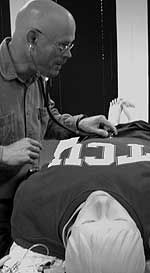|
Not
human, but almost
‘Hal’ helps ease nursing
students’ fears
By Joi Harris
Staff Reporter
Mary Beth Walker, the learning center director, stood
by as Hal’s breathing continued to get shallow,
and his heart started beating faster. As his blood pressure
dropped, his heart developed a life threatening rhythm.
Within five minutes, all of Hal’s life-functions
ceased. He was clinically dead.
That’s the bad news. The good news is that it was
part of a controlled simulation conducted by Walker
to demonstrate the capabilities of the $190,000 simulator
purchased by the Harris School of Nursing last summer.
Because there is little room for error in the medical
field, faculty and staff members of the Harris School
of Nursing said the department has purchased the sixth
version Human Patient Simulator, nicknamed “Hal,”
in order to relieve the amount of pressure and fear
students experience as part of their job, before they
actually come in contact with a real person.
“We want to make the student experience to be on
such a high level that the amount of fear they experience
is much less by the time they actually come in contact
with a living patient,” Walker said. “We can
make the situation intense enough to make virtual reality
real.”
The HPS, which is manufactured by Medical Education
Technologies, Inc., is a computer-driven, full-sized
mannequin that blinks, speaks and breathes. According
to the company’s Web site, the HPS mirrors human
responses to such procedures as CPR, intravenous medication,
ventilation and catheterization.
The Harris School of Nursing is the second school in
Fort Worth to purchase an HPS. John Uselding, director
of the simulator lab at Texas Wesleyan University, said
his department purchased an earlier model in 1999.
Uselding said students in Wesleyan’s nurse anesthesia
program use the department’s simulator to practice
administering anesthetics to patients.
Since 1999, Uselding said the students who have used
the simulator have received favorable comments from
their clinical coordinators.
Mike Sadler, the clinical coordinator at John Peter
Smith Hospital, said that students who have had experience
using simulators are able to handle the “finer
points” of their job.
“Because certain aspects of the nursing field is
driven a lot by technique, prior experience will enable
students to do a better job of multitasking, Sadler
said.
Brooks Zitzmann, a junior nursing major, is in her first
year of clinicals. She said Hal is a better bridge between
the lab and real life because it is technologically
a step above the type of mannequins she’s used
in the past.
“It’s a great tool for us to practice patient
care and study the physiological response to care without
real life implications,” Zitzmann said.
Hal currently resides on a $3,000 stretcher donated
by Harris Methodist Southwest Hospital. Walker said
the nursing hospital is seeking more donations from
Tarrant County hospitals.
|
|

|
|
Photo
editor/Sarah McClellan
|
|
| Senior
nursing major Neal Mikes uses a stethoscope
to listen to the heart beat of “Hal,”
the nursing department’s Human Patient
Simulator. |
|
| |
|

|
|
Photo
editor/Sarah McClellan
|
|
Senior
nursing majors Jeanne O’Neil and Neal Mikes
work on the nursing department’s Human Patient
Simulator, nicknamed “Hal.” The model
can simulate human functions such as breathing,
heart beat and bowel functions, among others.
|
|